
Giovanni Antonio Canal, commonly known as Canaletto, was an Italian painter from the Republic of Venice, considered an important member of the 18th-century Venetian school.
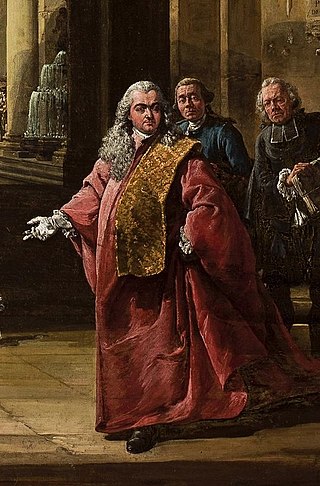
Bernardo Bellotto, was an Italian urban landscape painter or vedutista, and printmaker in etching famous for his vedute of European cities – Dresden, Vienna, Turin, and Warsaw. He was the student and nephew of the renowned Giovanni Antonio Canal Canaletto and sometimes used the latter's illustrious name, signing himself as Bernardo Canaletto. In Germany and Poland, Bellotto called himself by his uncle's name, Canaletto. This caused some confusion, however Bellotto’s work is more sombre in color than Canaletto's and his depiction of clouds and shadows brings him closer to Dutch painting.
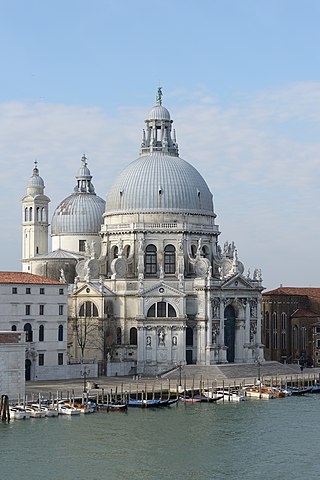
Santa Maria della Salute, commonly known simply as the Salute, is a Roman Catholic church and minor basilica located at Punta della Dogana in the Dorsoduro sestiere of the city of Venice, Italy.

Francesco Lazzaro Guardi was an Italian painter, nobleman, and a member of the Venetian School. He is considered to be among the last practitioners, along with his brothers, of the classic Venetian school of painting.

Giovanni Ambrogio Figino was an Italian Renaissance painter from Milan.

The Pinacoteca di Brera is the main public gallery for paintings in Milan, Italy. It contains one of the foremost collections of Italian paintings from the 13th to the 20th century, an outgrowth of the cultural program of the Brera Academy, which shares the site in the Palazzo Brera.
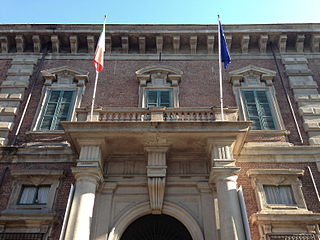
Palazzo Brera or Palazzo di Brera is a monumental palace in Milan, in Lombardy in northern Italy. It was a Jesuit college for two hundred years. It now houses several cultural institutions including the Accademia di Brera, the art academy of the city, and its gallery, the Pinacoteca di Brera; the Orto Botanico di Brera, a botanical garden; an observatory, the Osservatorio Astronomico di Brera; the Istituto Lombardo Accademia di Scienze e Lettere, a learned society; and an important library, the Biblioteca di Brera.
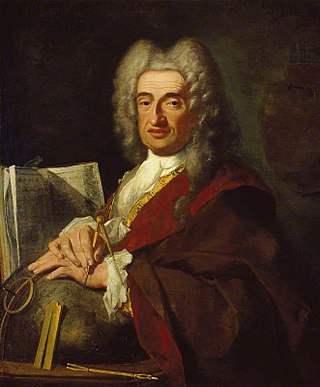
Luca Carlevarijs or Carlevaris was an Italian painter and engraver working mainly in Venice. He pioneered the genre of the cityscapes (vedute) of Venice, a genre that was later widely followed by artists such as Canaletto and Francesco Guardi.
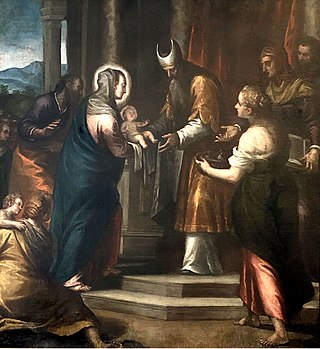
Alessandro Maganza (1556–1630) was an Italian painter of the Mannerist style, born and active in Vicenza, as well as in Venice.

Antonio d'Enrico, called Tanzio da Varallo, or simply il Tanzio was an Italian painter of the late-Mannerist or early Baroque period.

The Accademia di Belle Arti di Brera, also known as the Accademia di Brera or Brera Academy, is a state-run tertiary public academy of fine arts in Milan, Italy. It shares its history, and its main building, with the Pinacoteca di Brera, Milan's main public museum for art. In 2010 an agreement was signed to move the accademia to a former military barracks, the Caserma Magenta in via Mascheroni. In 2018 it was announced that Caserma Magenta was no longer a viable option, with the former railway yard in Via Farini now under consideration as a potential venue for the campus extension.
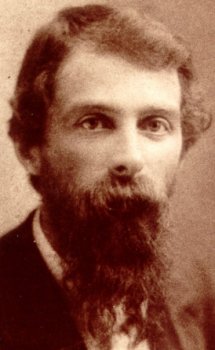
Giuseppe Pellizza da Volpedo was an Italian divisionist painter. He was born and died in Volpedo, in the Piedmont region of northern Italy.

Francesco Londonio was an Italian painter, engraver, and scenographer, active mainly in Milan in a late-Baroque or Rococo style.

Francesco Albotto (1721–1757) was an Italian painter from Venice, mainly producing vedute. He was a pupil of Michele Marieschi. After Marieschi's death, Albotto married his widow and took over his shop, and continued to produce paintings in a similar style until his own death, which has led to some problems in attributing paintings to Marieschi versus Albotto.
Ettore Modigliani was an Italian museum director and art historian.

Giovanni Agostino da Lodi was an Italian painter who was active from c. 1495 to c. 1525.

Carlo Urbino (1525/30–1585) was an Italian painter of the Renaissance.
Cherubino Cornienti was an Italian painter, active in a Romantic style mainly in Northern Italy.

Punta della Dogana is an art museum in one of Venice's old customs buildings, the Dogana da Mar. It also refers to the triangular area of Venice where the Grand Canal meets the Giudecca Canal, and its collection of buildings: Santa Maria della Salute,, the Patriarchal Seminary of Venice, and Dogana da Mar at the triangle's tip.

Pietro Rossi is an oil-on-canvas painting created in 1818–1820 by the Italian artist Francesco Hayez, now in the San Fiorano collection in Milan. A copy is in the Pinacoteca di Brera, also in Milan. Both show Pietro Rossi, accepting an invitation from Francesco Dandolo via a messenger to take command of the Venetian resistance to the expansionist Scaligeri. The work links a heroic past event to contemporary events and a Romantic sensitivity, as in historical novels of the same period such as Alessandro Manzoni's 1840 The Betrothed.

















